

February 2022 Interview with Rick Hwang, President of Rugged & Video Solutions Business Group at Getac

Getac's Mighty Class of 2021
January 2021 Interview with Rick Hwang, President of Rugged & Video Solutions Business Group at Getac

Getac V110 at Cirque du Soleil

Getac 25th Anniversary at 2014 Miramar Air Show

Getac FedEx TechConnect

TDI Panamericana 2011 team using Getac V100 on 16,000 mile endurance challenge
|

|

|
|
GETAC S410
Getac keeps their semi-rugged laptop state-of-the-art in performance, security and configurability, and then some
(by Conrad H. Blickenstorfer -- photography by Carol Cotton)
Getac introduced the next generation of its semi-rugged S410 notebook computer with faster processors, improved graphics, much faster storage, faster communication, much more battery power, and additional options. This latest Getac S410 looks the same, but it is a significantly improved and much more powerful machine now. And, in areas where it matters, a tougher one as well.

The Getac S410 is specifically designed for use in a wide variety of field applications that require more toughness and durability than consumer products can provide — such as field service, public safety, manufacturing, shop floors, as well as military applications, professional services, and vehicle use — but not the higher weight and cost of fully rugged laptops.
Getac S410 positioning
Overall, this latest Getac S410 remains a modern 14-inch laptop that's remarkably light and handy for this class of notebook computers, starting at just over five pounds. It is an attractive design using Getac's trademark matte black and gun-metal gray color scheme that signals toughness and professionalism.
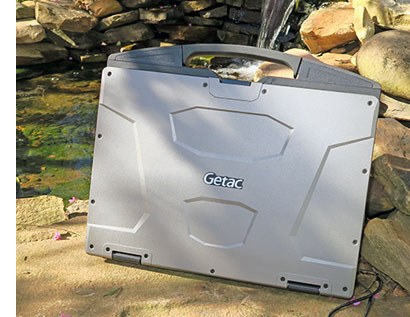 Now a word about the term "semi-rugged." It's a somewhat awkward term and it isn't clearly defined, but a better term just hasn't come along. Semi-rugged, in essence, describes a device that's more durable than your average consumer and even corporate notebook computer, but without going to extremes. Now a word about the term "semi-rugged." It's a somewhat awkward term and it isn't clearly defined, but a better term just hasn't come along. Semi-rugged, in essence, describes a device that's more durable than your average consumer and even corporate notebook computer, but without going to extremes.
Semi-rugged notebooks are for those whose laptops spend more time outdoors and on the road than on desks. Semi-ruggeds must be spill-proof, able to handle vibration, be viewable and usable at night as well as in bright sunshine. They must be fast and powerful, but also have great battery life, plenty of connectivity, and be handy enough to take anywhere. And, oh, they shouldn't cost a lot. At least not nearly as much as a fully-rugged laptop. That's quite a challenge.
The picture to the right says it all. No consumer notebook looks like this. The S410 is built tough enough to be used not just in an office but also outdoors and on the job. There's an integrated handle to carry the device without the need to bring along a bag for it. All of the ports have protective covers because it can get dusty and wet out there. And everything is built tough to absorb the occasional bump or drop. If the S410 were a vehicle it'd be a 4-wheel-drive SUV able to take a beating out there, but not as extreme (or expensive) as a dedicated military vehicle.
Since customers use these toughened-up laptops for a wide variety of applications, Getac customers can order the S410 with their choice of processor and numerous configuration options. Of special interest here is the Getac Select program where customers can easily get turn-key hardware software, accessories and solutions optimized for real-world challenges.
To provide an overview of just how much Getac improved and enhanced their S410 semi-rugged laptop platform, see the table below. This goes well beyond your standard hardware refresh.
|
Model
|
S410 G4 (2021)
|
S410 G3 (2019)
|
S410 G2 (2017)
|
S410 G1 (2016)
|
|
CPUs
|
Intel 11th gen
|
Intel 8th gen
|
Intel 8th gen
|
Intel 6th gen
|
|
Max RAM
|
64GB DDR4
|
64GB DDR4
|
32GB DDR4
|
16GB DDR3L
|
|
Primary storage
|
PCIe NVMe SSD
|
SATA SSD
|
Hard disk/SATA
|
Hard disk/SATA
|
|
2nd storage
|
SATA SSD
|
SATA SSD
|
SATA SSD
|
SATA SSD
|
|
Default LCD
|
1366 x 768, 1000 nits
|
1366 x 768, 1000 nits
|
1366 x 768, 1000 nits
|
1366 x 768, 1000 nits
|
|
Opt. LCD
|
1920 x 1080, 1000 nits
|
1920 x 1080, 800 nits
|
1920 x 1080, 800 nits
|
1920 x 1080, 800 nits
|
|
Max battery
|
2 x 74.5whr + 46.6whr
|
2 x 46.6whr
|
2 x 46.6whr
|
2 x 46.6whr
|
|
Temp range
|
-20° to 145°F
|
-20° to 145°F
|
-6° to 140°F
|
-6° to 140°F
|
|
IP rating
|
IP53
|
IP53
|
IP52
|
IP51
|
|
Weight
|
From 5.25 lbs
|
From 4.90 lbs
|
From 4.90 lbs
|
5.90 lbs as tested
|
|
Wi-Fi/BT
|
802.11ax/BT 5.1
|
802.11ax/BT 5.1
|
802.11ac/BT 4.2
|
802.11ac/BT 4.2
|
|
USB Type-A
|
2 x USB 3.2, USB 2.0
|
2 x USB 3.2, USB 2.0
|
3 x USB 3.0, USB 2.0
|
3 x USB 3.0, USB 2.0
|
|
USB Type-C
|
1 x Thunderbolt 4
|
NA
|
NA
|
NA
|
Not so long ago, it was rare to find up-to-date technology inside of semi-rugged and rugged computers due to the longer life cycles in vertical markets. That was not the end of the world, but certainly not what informed customers wanted for their increasingly complex and power-hungry applications.

Well, Getac certainly goes out of its way to provide their customers with state-of-the-art technology. Just a few months after Intel announced their "Tiger Lake" 11th generation of Core processors, they are already in the new Getac S410, leaving some of the competition three or even four generations behind. Intel considers these 11th gen mobile chips with their new Iris Xe graphics "a major leap forward in real-world processor performance and the best laptop processors we have built," while Getac's launch day press release speaks of "blisteringly fast performance."
Note that it is not just those fast new processors that make the new S410 a powerhouse. There is also super-fast PCIe NVMe solid state storage that replaces the default hard disk in earlier generations. Secondary storage stays with the older SATA type of solid state storage, but having PCIe NVMe technology for primary storage can make a HUGE difference.
Ditching hard disks also benefits other areas. Without a standard hard disk taking up a lot of space, Getac was able to go to bigger batteries. Whereas the S410 we tested in 2017 maxed out at two smallish 46.6 watt-hour batteries, the new S410 can pack two much more powerful 74.5 watt-hour batteries. That's 60% more battery power right there. And even that's not all. Getac also offers an optional 46.6 watt-hour battery in the multimedia bay. That's a major, major step forward in battery power. Battery life shouldn't be an issue with these news Getac S410s.
In terms of competition, the Getac S410 is squarely aimed at Panasonic's Toughbook 55, Dell's Latitude Rugged models, and the Durabooks laptops. There are also several Taiwan-based OEMs that sell durable and semi-ruggeds under various brand names and sometimes also their own. For customers seeking a semi-rugged from one of the major rugged computing vendors, the Getac S410 will definitely be on the short list.
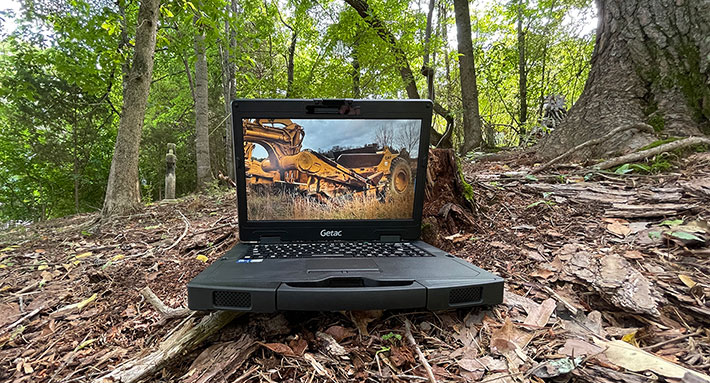
Design and construction
The Getac S410 was and is an attractive laptop, so there wasn't much that needed to be changed. The latest S410 retains Getac's trademark matte black and gun-metal gray color scheme and the contoured, sculpted and tough-looking top. The S410 signals toughness and that it's ready to go to work. It is industrial design at its best, with mechanical details — contours, exposed screws, reinforcements, etc. — suggesting industrial-grade machinery without overdoing it. It's certainly one of the best-looking ruggedized laptops out there. That said, the S410 remains a semi-rugged design. For those who need an all-out, no comprise fully rugged (and, of course, costlier) laptop, Getac has the B360. The S410 is made of ABS+PC polymer plastic material and not magnesium-alloy like the B360. You can hardly tell; the S410 looks and feels as tough and solid as the all-metal fully rugged models. Below you can see the S410 from the top and all four sides:
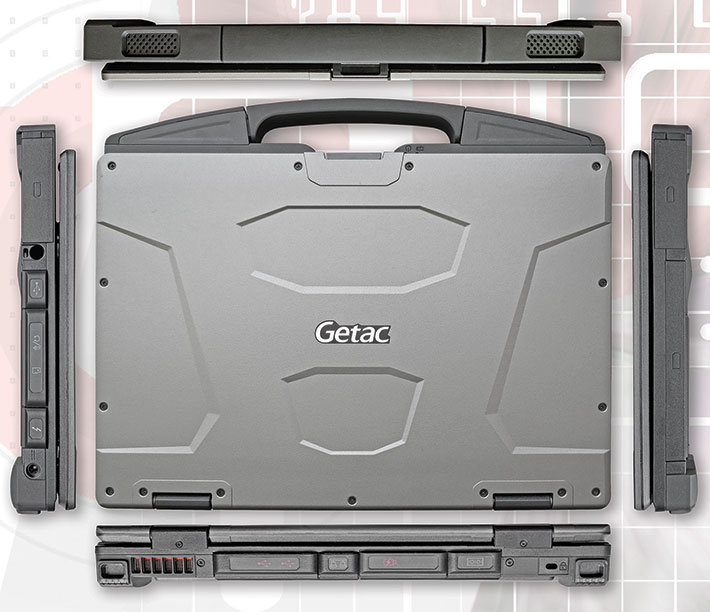
With the rugged good looks of the S410 it's easy to forget, however, that this is a semi-rugged machine that is not designed to be fully waterproof. Getac calls it "water resistant," which in this context means it can handle a spill onto its keyboard and also a good bit of rain. And there are protective doors that keep liquids away from ports. But the S410 is not a sealed machine. There are air vents and other openings to the inside through which liquids can get in.
As far as wired connectivity goes, the Getac S410 offers a lot. Along the backside (shown below with protective port covers removed) are from left to right:
- A standard HDMI port to connect a monitor
- Two USB 3.2 Gen 2 Type A ports
- An RJ45 gigabit LAN jack
- A PowerShare Type A USB port
- A DB15 VGA port (OR DisPlayPort OR DB9 RS232 serial)
- A DB9 RS232 serial port
- A Kensington lock slot

On the right side (shown below, again with protective port covers removed) you can see from left to right:
- The optional second battery
- The stylus slot
- A USB 2.0 Type A port
- The optional SIM card slot under protective cover)
- A combo audio jack
- This area could also have an optional Smart Card reader
- A USB Type C Thunderbolt 4 port
- The power jack

The bottom of this latest S410 is where we're seeing a very welcome change compared to the last S410 we reviewed in detail. Laptops generally have removable covers on the bottom so you can access memory and expansion slots. The last S410 we tested didn't and one had to remove the entire bottom half of the machine to get to those slots. That's changed now. The new S410 has two access doors, one for the RAM memory and one for the WiFi and mobile broadband modules. And since many of these laptops are used in agencies or enterprises that require the ability to quickly remove storage, the S410's Solid State Disk module can be removed in seconds.
We didn't have time to fully dismantle the latest S410 to see what everything looks like inside. The process would be the same as with the last one: remove some three dozen small screws and the housing comes apart easily. Getac doesn't generally use clips that can break off or wires or ribbons between the halves. And since this isn't a sealed design, there also isn't a perimeter seal to worry about. A nice design detail here: Getac is using two types of screws, most of them short, but some long. Screw holes where the long screws go are clearly marked. This way getting all the screws back into their proper place isn't trial-and-error. Service technicians appreciate that.
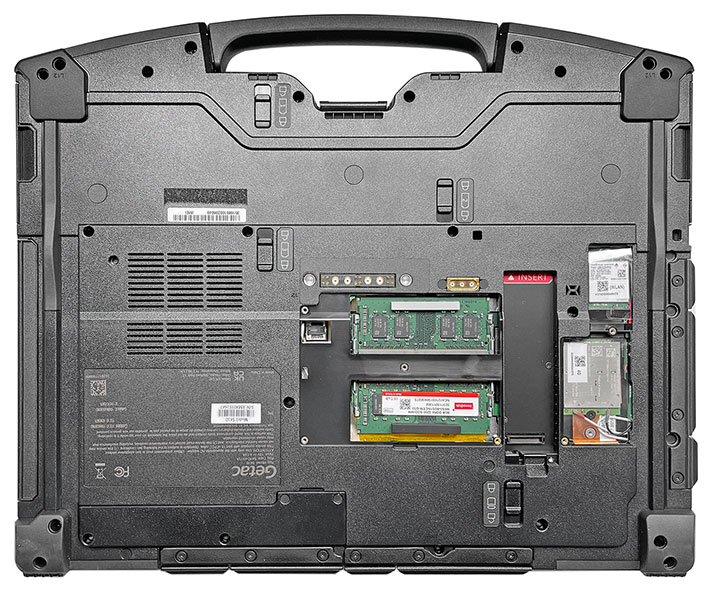
One thing that has been guiding the design of semi-rugged laptops for many years is their thermal management strategy. Electronics, and especially processors, generate a lot of heat and that heat must be dissipated reliably to guard against meltdowns. Heat can be removed either actively with fans or it can be passively removed with heat spreaders and heatsinks.
Fans don't weigh or cost a lot, they can move a lot of air, and fan speed can be actively managed. But fans are also noisy, they can get clogged, and like all mechanical things, they can fail. Heatsinks don't make noise and they don't need to be managed, but they are heavy and can get quite hot.
The original Getac S400 had a big fan to handle the heat generated by its standard voltage 37-watt TDP processor. The S410 has a much smaller fan because the platform has always used "ultra-low voltage" processors with 15-watt thermal design power. The images below were taken while the S410 was running performance benchmarks with our FLIR PNE Pro thermal camera that visually depicts surface temperature.
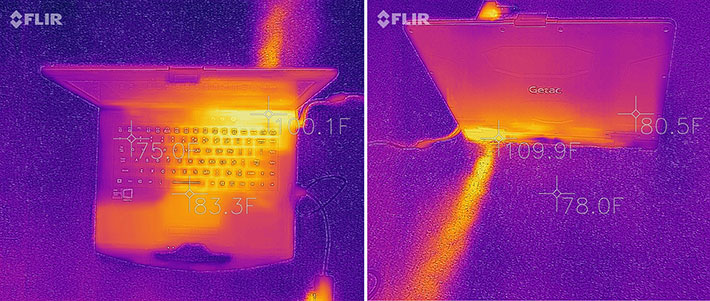
The thermal images show which parts of the S410 are heating up under load, those primarily being the active battery, the motherboard with all of its chips and, especially, the processor and the hat exchanger. The images clearly show the stream of hot air expelled by the fan. Under full load we saw exhaust temperatures of up to 110F in our lab. Fan noise varies with fan speed (the S410 fan can reach more than 7,000 rpm), and the S410 has a Fan Speed Control function in its G-Manager utilities suite where fan operation can be set for best performance or for quiet operation.
 One of the biggest changes in laptops over the past years is the switch from rotating hard disks to solid state disks (SSDs). When SSDs first became viable, their cost was high and manufacturers only offered them as expensive options with less storage capacity than hard disks. One of the biggest changes in laptops over the past years is the switch from rotating hard disks to solid state disks (SSDs). When SSDs first became viable, their cost was high and manufacturers only offered them as expensive options with less storage capacity than hard disks.
Even when prices came down, hard disks mostly remained the low-end default. And since SATA SSDs used the same 2-1/2 inch form factor as hard disks, storage bays continued to take up space. Today, 2-1/2 inch bays are mostly gone and main storage comes in the form of much smaller PCIe modules.
The image to the right shows the S410's primary PCIe NVMe storage module. The space saved by dropping 2-1/2 inch mass storage bays in favor of PCIe NVMe storage can be used in other ways like, as Getac has done, larger batteries.
Keyboard and hardware controls
A good keyboard is very important in a notebook for the field. If it isn't good, one might as well use a tablet. Getac's S400/S410 series of semi-rugged notebooks has seen several changes in its keyboard technology and layout over the time the platform has been available. The original S400 had beveled keys typical of the era. Getac then switched to a water-resistant mechanical membrane keyboard that used to be optional and looked a little busy. The initial S410 had an improved and more water-resistant 86-key "island-style" keyboard that was optimized for functionality, clarity and ease of use. That design looked and felt much like an Apple iMac keyboard, and we liked it a lot.
The new S410's keyboard remains island-style, but the keys are now more angular and the letters and symbols on the fatter and centered on the keys. From a purely visual and design standpoint, we preferred the older version.
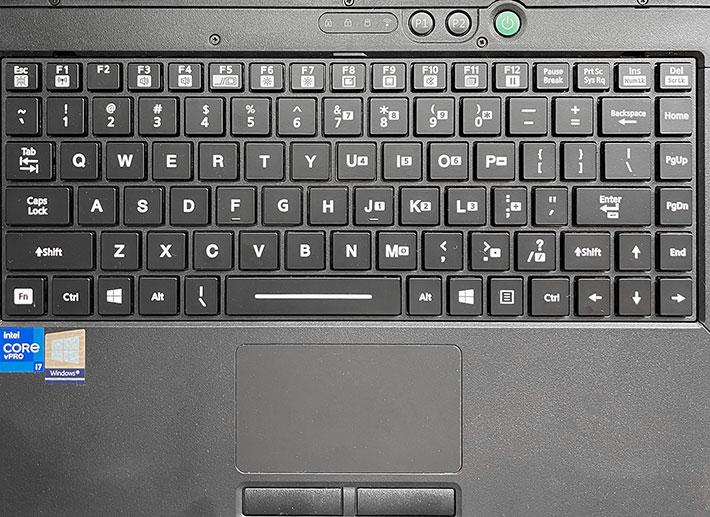
The touchpad and mouse button design remains largely the same. The two mouse keys are a bit more angular. The pad area is very slightly recessed. It uses capacitive multi-touch, works smoothly, but still has a bit too much stiction for precise movement. What is "stiction"? It's defined as "the friction that tends to prevent stationary surfaces from being set in motion." The stationary surface, in this instance, is the finger, and it takes a bit of force to move it, rather than just glide away.
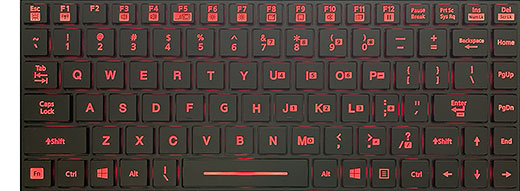 Our review S410 had an LED-based backlight that can be activated and toggled through three brightness settings via a function key combination. Illumination originally was blue, then switched to red, and stayed red on this latest S410. It is pleasant and clearly illuminates the keys in semi and full darkness. Our review S410 had an LED-based backlight that can be activated and toggled through three brightness settings via a function key combination. Illumination originally was blue, then switched to red, and stayed red on this latest S410. It is pleasant and clearly illuminates the keys in semi and full darkness.
One slightly distracting thing with this design remains that the illumination bleeds out around the keys in the dark. On the other hand, this also helps delineating the keyboard rather than having the labels just float in space.
Above the keyboard are three hardware pushbuttons, two of them programmable for frequently used operations, and a clearly marked green power button. This is a substantial improvement over the button design on the original S400, where it was easy to push the power button my mistake and the labeling wasn't very clear.
On our machine, one of the function buttons toggled the "sunlight readable" maximum screen brightness on and off, the other engaged the blackout function with the display and all indicator and other lights off. Having hardware buttons for these and other functions comes in handy. It's much quicker than fumbling with menus.
Performance: state-of-the-art processor technology
One of the goals Getac set for itself with the S410 was to deliver best-in-class performance. That's actually not so easy as overall system performance depends on numerous factors, including processor, memory, mass storage, configuration, software and more. Everyone has access to the same Intel processors and other components, and so it becomes a matter of building a system that optimizes competing demands. That requires a good crystal ball and making some difficult decisions. For example, fast is always good and customers love it, but in notebooks fast generally also brings a bigger battery, more cooling, and that means higher weight and cost.
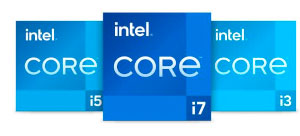 As of this writing (early June 2021), of the semi-rugged laptop competition, the Panasonic Toughbook 55 and Dell's Latitude 5420/5424 are still at the 8th generation of Intel Core processors. The Getac S410 and the latest generation of Durabook's S14I, on the other hand, are built around Intel's 11th generation of Core processors. Intel's 12th generation — Alder Lake — will be here soon enough, but for now 11th gen "Tiger Lake" is it. As of this writing (early June 2021), of the semi-rugged laptop competition, the Panasonic Toughbook 55 and Dell's Latitude 5420/5424 are still at the 8th generation of Intel Core processors. The Getac S410 and the latest generation of Durabook's S14I, on the other hand, are built around Intel's 11th generation of Core processors. Intel's 12th generation — Alder Lake — will be here soon enough, but for now 11th gen "Tiger Lake" is it.
Overall, there haven't been very drastic changes in the last few generations of Intel's Core processors. It's difficult to make gates (really transistors) smaller and smaller, and Intel has spent much time fine-tuning and optimizing their chips over the past few years. There have been milestones such as making mobile quad-core chips available in the "Coffee Lake" 8th generation. And now we may be seeing another in the "Tiger Lake" 11th generation used in the Getac S410 and the reason may be different from what one might expect.
Before we get into that, here's a list of all the processor options available for the Getac S410 (to view the full Intel spec table for these five CPUs, see here):
|
2021 Getac S410: Available Intel Core processor options
|
|
Available S410 CPUs
|
Intel Core i7
|
Intel Core i7
|
Intel Core i5
|
Intel Core i5
|
Intel Core i3
|
|
Model
|
1185G7
|
1165G7
|
1145G7
|
1135G7
|
1115G4
|
|
Cores/Threads
|
4/8
|
4/8
|
4/8
|
4/8
|
2/4
|
|
Base Clock Speed
|
1.20 GHz
|
1.20 GHz
|
1.10 GHz
|
0.90 GHz
|
1.70 GHz
|
|
Turbo Speed
|
4.80 GHz
|
4.70 GHz
|
4.40 GHz
|
4.20 GHz
|
4.1 GHz
|
|
TDP-up
|
28 watts, 3.00GHz
|
28 watts, 2.80GHz
|
28 watts, 2.60GHz
|
28 watts, 2.40GHz
|
28 watts, 3.00GHz
|
|
TDP-down
|
12 watts, 1.20GHz
|
12 watts, 1.20GHz
|
12 watts, 1.10GHz
|
12 watts, 0.90GHz
|
12 watts, 1.70GHz
|
|
Smart Cache
|
12MB
|
12MB
|
8MB
|
8MB
|
6MB
|
|
Integrated graphics
|
Iris Xe
|
Iris Xe
|
Iris Xe
|
Iris Xe
|
UHD Graphics
|
|
Graphics max speed
|
1.35 GHz
|
1.30 GHz
|
1.30 GHz
|
1.30 GHz
|
1.25 GHz
|
|
Graphics Execution Units
|
96
|
96
|
80
|
80
|
48
|
|
Relative CPU cost
|
1.53
|
1.53
|
1.10
|
1.10
|
1.00
|
|
Intel Stable Image Platform Program
|
Yes
|
No
|
Yes
|
No
|
No
|
|
Intel TSX-NI
|
Yes
|
No
|
Yes
|
No
|
No
|
|
Intel Trusted Execution
|
Yes
|
No
|
Yes
|
No
|
No
|
|
Intel vPro
|
Yes
|
No
|
Yes
|
No
|
No
|
The top processor option for the Getac S410 is the Intel Core i7-1185G7 (installed in our review unit). This high-end chip offers the highest maximum turbo frequency as well as the highest frequencies at the 28 watt and 12 watt TDP-Up and TDP-down settings. Next in line is the Core i7-1185G7. It is a bit slower overall and doesn't include some of Intel's special technologies. Next are two Core i5 chips that have only 8MB instead of 12MB SmartCache, fewer graphics execution units, as well as small clock frequency and included Intel technology differences. The low-end i3-1115G4 chip is the only one with just two cores instead of four, and also the only one without Intel's more powerful new Iris Xe graphics.
What may make a difference in certain applications is the availability of four special Intel technologies (vPro, TME, SIPP, and Trusted Execution) included in the i7-1185G7 and i5-1145G7, but not in the other three processors. Here's what that means:
- The extra security and manageability capabilities of vPro, especially, are required in many enterprise deployments.
- TME (Total Memory Encryption) ensures that all memory accessed from the CPU is encrypted, including customer credentials, encryption keys, and other IP or personal information on the external memory bus.
- SIPP (Stable Image Platform Program) allows deployment of standardized, stable image PC platforms for at least 15 months, and
- Trusted Execution technology provides security capabilities such as measured launch and protected execution, and may thus also be an enterprise requirement.

To see what kind of performance the new quad-core Getac S410 can achieve, we ran our standard benchmark suites, Passmark Software's PerformanceTest 6.1 and 9.0 that include dozens of tests covering CPU, 2D graphics, 3D graphics, memory, and disk and then computes scores for each category and an overall PassMark scores. We also ran our second benchmark suite, CrystalMark, to provide some clues as to overall single core performance. We're also showing results of three other major benchmark suites that we've recently added to out test program: PC Mark 10, GeekBench 5 and one of the most often used 3DMark graphics benchmarks, Time Spy.
To provide an idea where the S410 stands in terms of overall performance, the below table also includes results of the fully rugged Getac B360 as well as some of the S410s prominent semi-rugged competition.
The results are as follows:
|
Getac S410 Benchmarks and Comparisons
|
|
Manufacturer
|
Getac
|
Getac
|
Dell
|
DT Research
|
Durabook
|
Panasonic
|
|
Model (year tested)
|
S410
|
B360 (2020)
|
Latitude 5420
|
LT330
|
DURABOOK S14I
|
TOUGHBOOK 55
|
|
CPU Type: Intel
|
Core i7
|
Core i7
|
Core i7
|
Core i7
|
Core i7
|
Core i5
|
|
CPU Model and gen
|
1185G7 (11th)
|
10710U (10th)
|
8650U (8th)
|
10710U (10th)
|
1165G7 (11th)
|
8365U (8th)
|
|
Thermal Design Power (TDP)
|
12/28 watts
|
15 watts
|
15 watts
|
15 watts
|
12/28 watts
|
15 watts
|
|
BatteryMon min draw
|
3.8 watts
|
2.2 watts
|
3.2 watts
|
3.7 watts
|
5.5 watts
|
3.3 watts
|
|
PassMark 6.1
|
8,292.7
|
6,430.2
|
5,331.3
|
7,284.8
|
10,338.7
|
4,424.4
|
|
PassMark 9.0
|
5,637.2
|
4,531.8
|
3,906.9
|
3,948.8
|
5,164.5
|
3,325.6
|
|
CrystalMark
|
488,622
|
333,057
|
312,630
|
336,613
|
455,646
|
296,834
|
|
PCMark 10
|
4,876
|
4,265
|
NA
|
NA
|
4,570
|
NA
|
|
3DMark Time Spy
|
1,579
|
1,520
|
NA
|
NA
|
1,040
|
NA
|
|
GeekBench 5
|
1,545
|
1,238
|
NA
|
NA
|
1,496
|
NA
|
What do these numbers show? In essence that the new Getac S410 with the most powerful of the five offered 11th generation Core processor is very fast, even compared to powerful top-of-the-line machines running on 10th generation Intel Core processors. The performance difference is greater than one would expect from the usually relatively small performance increases between Intel Core processor generations. The new Getac S410 is not only much faster than the prior generation S410, but also considerably faster than anything still running on older Intel chip generations. While the relatively recent switch from SATA to much faster PCIe NVMe mass storage certainly helped, the answer must be in the 11th gen Core processor.
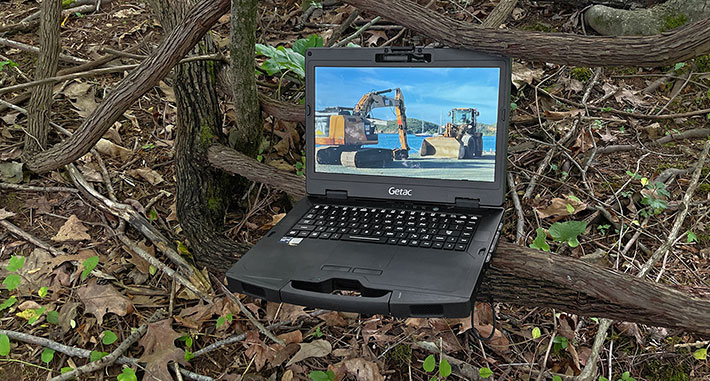
Power draw and battery life
So what is the impact of this excellent performance on the S410's battery life? The competition has traditionally set the battery life bar pretty high in this class and we've seen furious quests from all sides to offer the thinnest, lightest machine with the best possible battery capacity and battery life, as well as the highest possible performance.
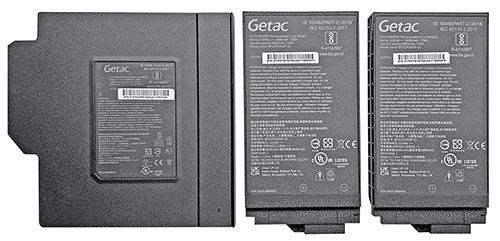 Perhaps for that reason the Getac S400/S410 semi-rugged laptop platform has seen several changes since its initial release. The original S400's battery was a massive 10.8 Volt/8,700mAH 94 watt-hour unit that weighed over a pound all by itself. When the first S410 came around a few years later, it came with two 46.6 watt-hour smaller batteries, both with equal 46.6 watt-hour capacity. The smaller batteries allowed for a thinner profile, and thanks to Getac's switch to more efficient ultra-low voltage processors, the S410 beat the older S400's battery life even with just one of its much smaller batteries. In addition, dual batteries, also them hot-swappable. Perhaps for that reason the Getac S400/S410 semi-rugged laptop platform has seen several changes since its initial release. The original S400's battery was a massive 10.8 Volt/8,700mAH 94 watt-hour unit that weighed over a pound all by itself. When the first S410 came around a few years later, it came with two 46.6 watt-hour smaller batteries, both with equal 46.6 watt-hour capacity. The smaller batteries allowed for a thinner profile, and thanks to Getac's switch to more efficient ultra-low voltage processors, the S410 beat the older S400's battery life even with just one of its much smaller batteries. In addition, dual batteries, also them hot-swappable.
Now things have changed once more with the latest S410. The standard hard disk, which took up a lot of space, has been replaced with a much smaller solid state disk. So instead of the two smallish 46.6 watt-hour batteries in the prior gen S410, the new S410 can pack two much more powerful 74.5 watt-hour batteries AND an optional 46.6 watt-hour battery in the multimedia bay. Huge, huge improvement.
And also going one up on the semi-rugged compeition: Dell offers one or two 51 watt-hour batteries for their Latitude 5420 Rugged, with an estimated combined run time of 14 hours. Durabook, likewise, offers one or two 51 watt-hour batteries in its DURABOOK S14I, estimating 20 hours of runtime with both. The Panasonic TOUGHBOOK 55 offers one or two 68 watt-hour batteries with an estimated combined run time of 40 hours. The new S410 beats them all with a total possible battery capacity of 195.6 watt-hours.
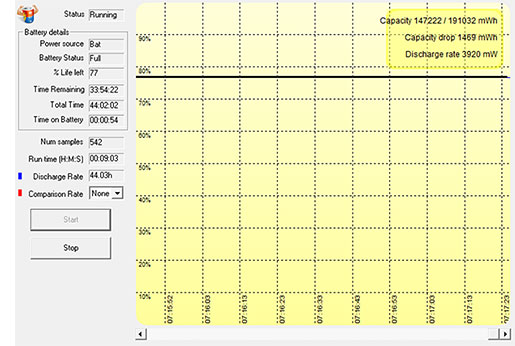 We tested power draw of the new Getac S410 by running our standard BatteryMon benchmark. With Windows Power setting set to "Power Saving," the Windows task bar Power Mode slider set to "Best battery life" and the display backlight set to its lowest setting, we saw a minimum of about 3.8 watts. That's theoretically good for 19.6 hours with just one battery and 39.2 hours with two batteries. We tested power draw of the new Getac S410 by running our standard BatteryMon benchmark. With Windows Power setting set to "Power Saving," the Windows task bar Power Mode slider set to "Best battery life" and the display backlight set to its lowest setting, we saw a minimum of about 3.8 watts. That's theoretically good for 19.6 hours with just one battery and 39.2 hours with two batteries.
With the backlight set to roughly 50% for comfortable indoor viewing, we saw a minimum of 4.6 watts, theoretically good for 16.2 hours with one battery and 32.4 hours with two. And with the backlight set to maximum brightness, we still only saw a minimum of 5.7 watts, still theoretically good for 13.1 hours with one battery and 26.2 hours with both.
|
Getac S410 2021 BatteryMon Power Draws (at idle)
|
|
Backlight level
|
Darkest
|
50%
|
Brightest
|
|
Max Battery
|
3.8 watts (19.6 hrs.)
|
4.6 watts (16.2 hrs.)
|
5.7 watts (13.1 hrs.)
|
|
Max Performance
|
3.8 watts (19.6 hrs.)
|
4.8 watts (15.5 hrs.)
|
9.8 watts (7.6 hrs.)
|
We then switched the Windows Power setting set to "Extreme" and the Windows task bar Power Mode slider to "Best performance." That way, with the display backlight set to its lowest setting, we saw the same minimum of about 3.8 watts. With the backlight set to 50% for comfortable indoor viewing, we recorded 4.8 watts, almost the same also. And with the backlight set to maximum brightness, power draw rose considerably to 9.8 watts, still theoretically good for 7.6 hours with one battery and 15.2 hours with both.
We noticed, however, that 100% brightness in the "Extreme/Best performance" setting was MUCH brighter than 100% brightness in the "Power saving/Best battery life" mode. There are a lot of variables that go into those various power settings, and it's not immediately obvious why maximum brightness is linked to maximum performance.
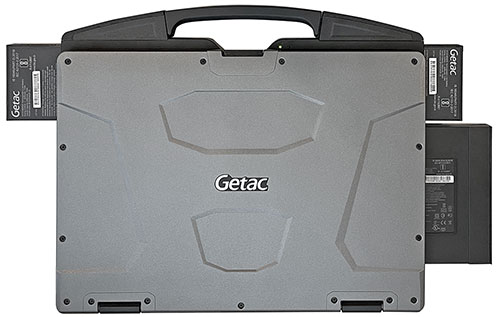 Real-world mileage will of course vary, as always. Minimum draw in a test lab is not an accurate predictor of actual battery life. Intel's Core processors have become very good at conserving power, to the extent where their recorded "idle" draw is actually often less than that of many Atom processors. Under full load, of course, the powerful Core chip will draw more than the limited Atom CPU. Real-world mileage will of course vary, as always. Minimum draw in a test lab is not an accurate predictor of actual battery life. Intel's Core processors have become very good at conserving power, to the extent where their recorded "idle" draw is actually often less than that of many Atom processors. Under full load, of course, the powerful Core chip will draw more than the limited Atom CPU.
Even so, between the excellent power management of Intel's 11th generation Core processors, Windows' much improved power management, and the Getac S410's extensive power management settings, if need be, the S410 can run a very, very long time on a charge, especially with all three batteries installed.
Bottomline here is that this latest generation of the Getac S410 is significantly more energy efficient than earlier S400 and S410 models. The first S400 we tested ten years ago drew a full 11.6 watts just idling along, even though the machine was only a fraction as powerful as today's machine.
Bright and very good 14-inch display
The Getac S410's 14-inch display is more than large enough to allow working without squinting. The standard display remains at 1366 x 768 pixel resolution, which is legacy by now and we'd have liked to see the optional 1920 x 1080 pixel display become standard. As is, the default 1366 x 768 screen is very bright (1,000 nits) but doesn't have touch. Touch isn't really needed on a laptop, but with Windows 10 it's increasingly useful and a good thing to have.
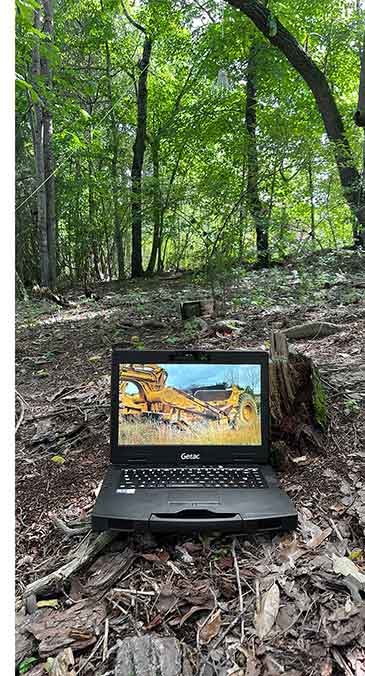 The Getac S410 display's 16:9 aspect ratio gives the computer a contemporary look (some older rugged laptops still use the squarish 4:3 aspect ratio). Compared to the 1024 x 768 pixel XGA resolution that was the gold standard in rugged notebooks for many years, the standard display's 1366 x 768 pixel resolution is like getting getting an additional third added on the side. The Getac S410 display's 16:9 aspect ratio gives the computer a contemporary look (some older rugged laptops still use the squarish 4:3 aspect ratio). Compared to the 1024 x 768 pixel XGA resolution that was the gold standard in rugged notebooks for many years, the standard display's 1366 x 768 pixel resolution is like getting getting an additional third added on the side.
That said, time has moved on, and with smartphones and consumer tablets now offering very high resolution, customers more and more expect the same form laptop screens. Our evaluation unit had the optional 1920 x 1080 pixel display, which makes for 157 pixels per inch. That's still not "retina" type of resolution, but it is very noticeably sharper than the 1366 x 768 default screen. This would definitely be our preferred screen option for the S410.
Display size, though, isn't everything. Most rugged notebooks, including the S410, will be used outdoors and sometimes in bright, direct sunlight. Standard transmissive LCD displays, however, wash out in daylight, and that's why over the past few years, sunlight-readability has become a major selling point in the rugged notebook sector. The currently most popular way of making a notebook screen readable outdoors combines various optical treatments to control internal reflection with a strong backlight.
A few words about screen brightness here: A standard notebook backlight is in the 200 nits luminance range (1 nit = 1 candela per square meter) range. Some manufacturers up the brightness in their rugged products, usually into the 300-400 nits range. Industrial monitors used outdoors generally have 400 to 500 nits. High end rugged notebooks offer anywhere from 500 to over 1,000 nits, with Getac offering as much as 1,400 nits in its B360 ultra-rugged. What this means is that the 1,000 nits backlight of the S410's 1920 x 1080 display is much brighter than any consumer notebook. And when we measured the new S410's luminance in our lab we found that Getac understated; our equipment measured 1145 nits.
But aren't bright backlights bad for battery life? Yes, and that's why S410 users can easily toggle between "sunlight readable" on and off by pushing the P2 function button. 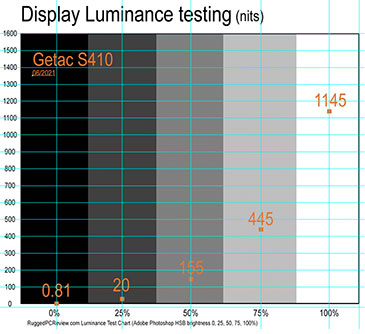 Having that hardware button is the key to keeping power draw in check: when you need the extra-strong backlight, switch it on. When you don't need it anymore, turn it off. That's much easier with a button than via menus or function keys (both of which are also available in the S410). Having that hardware button is the key to keeping power draw in check: when you need the extra-strong backlight, switch it on. When you don't need it anymore, turn it off. That's much easier with a button than via menus or function keys (both of which are also available in the S410).
A few additional comments about the S410 display. While we described it as glossy above, semi-gloss would best describe it. Reflections on it are far more muted than those of most consumer laptops and tablets, almost all of which have high-gloss displays.
And there's another quality the S410 display has: it's remarkably immune to the smudges and fingerprints that quickly mar almost all glossy displays.
Viewing angles are important. Both horizontal and vertical viewing angles of this latest S410 screen are very good, without any color shifts even when viewed at extreme angles. That's a welcome change from earlier S410s we reviewed where we noticed considerable vertical angle color shifts. Getac fixed that. Much appreciated!
Multi-touch and an very good narrow-tip capacitive stylus
If you want touch, there are two options. One is a multi-touch version of the default screen. The other is the 1920 x 1080 pixel capacitive multi-touch display whose luminance has been boosted from 800 nits to 1,000 nits in the new S410.
Touch used to be an uncommon option on notebook computers, but tablets and Windows 10 have changed all that. Touch is now considered part of the computing experience, and it has become almost mandatory. And, of course, not just any touch, but capacitive multi-touch. That's the default these days, and has been ever since the iPhone introduced that elegant, effortless tapping, panning, pinching and zooming to the world.
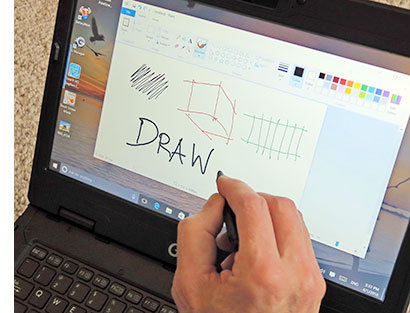 That said, while capacitive multi-touch works great on tablets and all those iOS and Android apps specifically developed for handhelds and tablets, Windows was not developed for touch and it can be a bear to use even Windows 10 with touch, especially when using the legacy desktop and legacy Windows software with all those tiny check boxes, screen borders and scrollers. Windows 10 is more touch-optimized, but it'll likely take a few more changes to Windows before it's truly touch-optimized. And whether reaching over a full-scale keyboard to touch a display will ever become fully natural is anyone's guess. That said, while capacitive multi-touch works great on tablets and all those iOS and Android apps specifically developed for handhelds and tablets, Windows was not developed for touch and it can be a bear to use even Windows 10 with touch, especially when using the legacy desktop and legacy Windows software with all those tiny check boxes, screen borders and scrollers. Windows 10 is more touch-optimized, but it'll likely take a few more changes to Windows before it's truly touch-optimized. And whether reaching over a full-scale keyboard to touch a display will ever become fully natural is anyone's guess.
How did Getac address this tough predicament in the S410? By offering both remarkably smooth and responsive capacitive multi-touch, and a very good capacitive stylus.
A word about the capacitive stylus. Capacitive styli have been around almost as long as capacitive multi-touch tablets, but most have broad rubber or mesh tips that make them all but useless for anything but tapping on the screen. The stylus that comes with the S410 has a hard and much narrower 3.5mm tip. That's roughly the size of a Sharpie permanent marker tip. The tip is spring-loaded, though it doesn't appear to have pressure-sensitive functionality. The picture below shows the new stylus that comes standard with the S410. It is 4.75 inches long and neatly stows away in a garage on the right side of the laptop.

While the narrow-tipped S410 stylus is much better than those old broad ones, don't expect the precise and smoothly flowing ink possible with an active Wacom-style digitizer. But it's much better for drawing or, if you use it, handwriting recognition than any resistive stylus.
Works with gloves and when it's wet
Another issue with capacitive touch is that it in its generic form, it only works with human fingers or, to a lesser extent, with capacitive styli. Standard capacitive touch doesn't like rain and it won't accept gloves. Unfortunately, wetness and the need for gloves is exactly what one often encounters where ruggedized computing gear such as the Getac S410 is used. 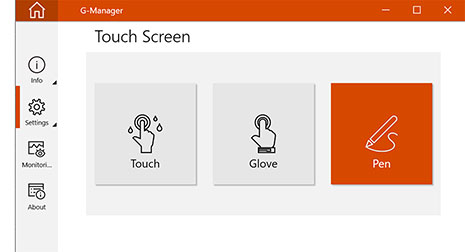 Getac knows that and was one of the first to address that issue years ago in their early V110 and F110 models. Ever since, most rugged Getac devices have a G-Manager "Touch" tab where users can select "Touch," "Glove," or "Pen." Getac knows that and was one of the first to address that issue years ago in their early V110 and F110 models. Ever since, most rugged Getac devices have a G-Manager "Touch" tab where users can select "Touch," "Glove," or "Pen."
Touch" — Drops near the hand on the "Touch" icon suggest that touch continues to work "with direct exposure to rain." That is something regular capacitive displays struggle with. Water is so conductive that it affects the capacitance between two electrodes, which is the concept upon which projected capacitive touch is built. The pen does not work in this mode.
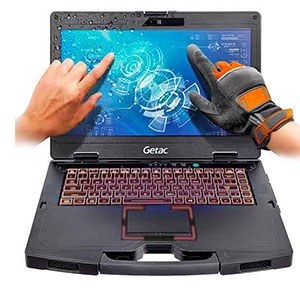 What can be done is switching from a standard mutual capacitance mode to self-capacitance where the capacitance between one electrode and the ground is measured instead of the capacitance between two electrodes. The S410's passive pen does not work in this mode, which would point toward a self-capacitance solution (unlike in the Getac V110 where the passive pen continues to work in wet mode), but Getac says they used controller sensitivity to handle the job. The pen works in this mode. What can be done is switching from a standard mutual capacitance mode to self-capacitance where the capacitance between one electrode and the ground is measured instead of the capacitance between two electrodes. The S410's passive pen does not work in this mode, which would point toward a self-capacitance solution (unlike in the Getac V110 where the passive pen continues to work in wet mode), but Getac says they used controller sensitivity to handle the job. The pen works in this mode.
"Glove" allows the S410 to be operated with gloves. That is usually done by increasing the sensitivity of the touch controller, so that it can recognize a finger even a brief distance away from the screen, as in the distance that the material of a glove adds to the finger's distance from the screen. That's the way Getac seems to have done it, as not only do gloves work in this mode, but the cursor now follows the finger even when it is a short distance away from the surface, and touch operations no longer require a firm touch.
"Pen" is optimized for use with the pen, but finger touch works as well.
Security
Like most mobile hardware these days, the S410 offers various levels of hardware and software security to prevent unauthorized access as well as theft. That includes multifactor authentication via passwords, fingerprint reader, Smart Card reader, HF RFID reader, and Windows Hello face-authentication camera.
Our system included Intel Trusted Platform Module (TPM) 2.0 hardware security for enhanced boot process integrity, and to create and manage computer-generated digital certificates. Combined with the Windows Hello software in Windows 10, it can encrypt biometric data. In addition, TPM can be used to create certificates that can be used to:
- Send and receive secure email,
- Set up the browser for client identification,
- Sign Word macros,
- Encrypt individual files or entire folders, and
- Create secure network connections.
Fingerprint registration software works with the S410's fingerprint scanner that now uses capacitive technology so users can just place their finger on the scanner rather than swiping.
All of this can get pretty involved. Some users may never implement TPM, fingerprint scanning or even passwords, whereas others may be set up in accordance with their company's IT security procedures, or they may configure an individual system for maximum security.
Over all this, don't forget physical security and get a Kensington locking cable to use with the Kensington slot on the backside of the unit. It is inexpensive insurance against theft.
Additionally, depending on the processor, S410s can be configured with Intel vPro, a set of technologies to remotely access and control computers securely. And Absolute DDS (stands for Device & Data Security, formerly known as CompuTrace) is also optionally available. The way that works is that there's a constant two-way between device so that risk can be monitored and assessed remotely, and the device disabled if need be.
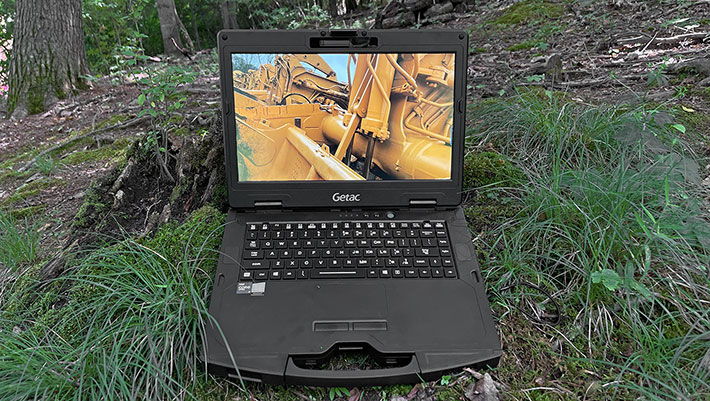
Docking and vehicle mounting
 Semi-rugged notebooks such as the Getac S410 are often used in vehicles. To that extent, Both Gamber-Johnson and Havis are offering vehicle docks for the S410. These can be mounted in numerous ways, using the dock manufacturers' solutions or the vast variety of RAM ball and joint components. Semi-rugged notebooks such as the Getac S410 are often used in vehicles. To that extent, Both Gamber-Johnson and Havis are offering vehicle docks for the S410. These can be mounted in numerous ways, using the dock manufacturers' solutions or the vast variety of RAM ball and joint components.
The S410 has separate antenna pass-throughs for GPS, WLAN and WWAN. These are supported by the vehicle docks, which makes roof-mount antennae possible. A set of pogo docking pins on the bottom of the S410 allow the docks to provide port duplication and additional I/O functionality.
Ruggedness
We don't really like the term "semi-rugged" very much because it implies less than really and truly rugged. While the S410 is not as tough and well-protected as Getac's B360 or X500 laptops, the point really is that the S410 is far more rugged than all those 100+ million consumer and business laptops sold every year.
As is, Getac says the S410 was designed "to meet or exceed MIL-STD-810G temperature, shock, humidity, altitude and vibration specifications." Getac also claims a 3-foot drop. That's generally enough to let a unit survive a fall from a desk. The S410's corner rubber bumpers certainly help, as does the integrated rubber handle. But with no more hard disk to worry about, it could likely be four feet with just a bit of extra corner protection.

Getac says the new S410 can operate between -20° and 145° Fahrenheit (-29° to 63°C). That's wider than before (likely due to dropping the hard disk entirely) and makes the new S410 suitable for use in almost any environment. The wide range comes in handy in several targeted deployments, such as closed vehicles or around freezers.
As far as sealing goes, there's been steady progress. The original S400's IP5x rating meant there was no ingress protection against liquids at all. The first S410 carried an IP51 rating, the 2nd gen S410 was IP52, and the latest generation has been upgraded to IP53 where the "5" means that the unit is protected against dust and the "3" that it's also protected against water spray from above within a 15 degree angle.
Getac designed the S410 to handle common occurrences such as spills onto the keyboard and keypad, and all ports have protective (albeit potentially fingernail-busting) covers.
Note that Getac offers optional rugged I/O connectors for customers who need them. The previous generation S410 could be ordered with Fischer Connectors' rugged 5-pin USB 2.0 and rugged 9-pin LAN ports, and we assume that applies to the new model as well.
Getac's S410 specs state that the unit is "MIL-STD-810G certified" and drop and vibration resistant. That alone doesn't say much, but Getac undoubtedly can produce more detailed test documents so that prospective customers can see what, exactly, the unit can handle and what it cannot. What became clear in our testing, though, is that the S410 feels very sturdy and very trust-inspiring. While its looks probably suggest it is even tougher than it is, this machine seems plenty capable of handling the likely abuse encountered in its intended deployments.
Bottom line: Getac S410
With the latest generation of the S410, Getac keeps their semi-rugged laptop platform state-of-the-art and beyond, providing the very latest in scalable performance and economical operation. With the tech-update and refresh, Getac also made sure their S410 took its turn leapfrogging the Panasonic Toughbook 55, which saw its last big upgrade a couple of years ago.
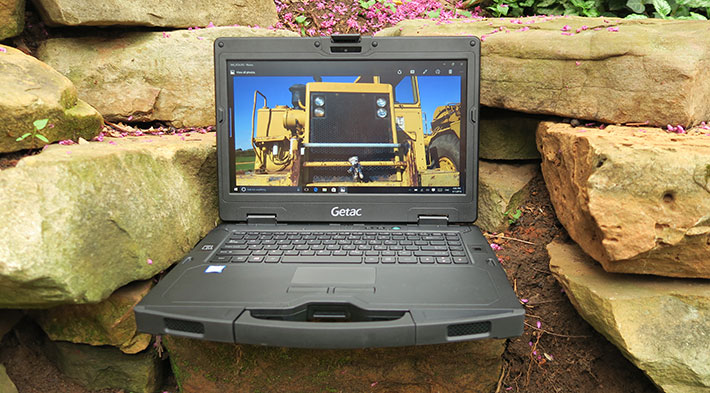
The S410 has shed more than a quarter of its predecessor's thickness and close to a quarter of its weight, making for an entirely more contemporary computer for field mobile or vehicular deployments in public safety, armed forces, government, field service, manufacturing and professional services. This was made possible by switching from 4th generation "Haswell" processors in the S400 to 6th generation "Skylake" CPUs in the S410. The move allowed the use of ultra-low voltage instead of standard voltage chips without giving up any performance and getting the same battery life from a much smaller battery.
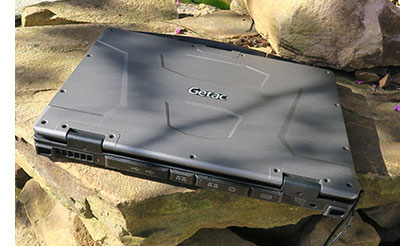 Prior generations of the Getac S410 were very reasonably priced (higher-end and specially equipped models go for considerably more, of course), balanced excellent performance, long battery life, customizable connectivity, and sufficient ruggedness for many tasks into a very attractive package that matched up very well with the competition. If anything, this latest generation aims higher yet, and so we expect it to be quite popular. Prior generations of the Getac S410 were very reasonably priced (higher-end and specially equipped models go for considerably more, of course), balanced excellent performance, long battery life, customizable connectivity, and sufficient ruggedness for many tasks into a very attractive package that matched up very well with the competition. If anything, this latest generation aims higher yet, and so we expect it to be quite popular.
The S410 is available with several Intel "Tiger Lake" 11th generation processor options. Our test unit, equipped with the top-of-the-line Core i7-1185G7 processor turned in superior benchmark performance. For maximum graphics performance, an NVIDIA GeForce GTX 1650 discrete GPU is offered. Despite its excellent performance, the S410 offers very good battery life with one battery, and exceptional battery life with two or three. Between rich onboard I/O, optional port configurations, and a very flexible multi-purpose media bay, there's little the S410 can't do.
"Semi-rugged" design here essentially means the ability to survive a reasonable degree of shocks, vibration, spills, etc., without incurring the extra cost and weight of full ruggedness. The S410, however, is not a sealed device.
Overall, the semi-rugged Getac S410 laptop computer, which starts at a reasonable US$1,699 (Intel Core i5-1135G7, 8GB RAM, 256GB PCIe NVME), skillfully balances excellent performance, vastly customizable connectivity, and sufficient ruggedness for many tasks into a very attractive package that matches up very well with the competition. -- Conrad H. Blickenstorfer, July 2021
|
Getac S410 Gen 4 (2021) semi-rugged notebook Specs
|
| Type |
Semi-rugged notebook
|
| Introduced |
Introduced January 2021
|
| Processor |
Intel Core i7-1185G7
Intel Core i7-1165G7
Intel Core i5-1145G7
Intel Core i5-1135G7
Intel Core i3-1115G4e
|
| Max CPU clock speed |
i7-1185G7: 4.80 GHz
i7-1165G7: 4.70 GHz
i5-1145G7: 4.40 GHz
i5-1135G7: 4,20 GHz
i3-1115G4: 4.10 GHz
|
| CPU Smart Cache |
i7-1185G7: 12MB
i7-1165G7: 12MB
i5-1145G7: 8MB
i5-1135G7: 8MB
i3-1115G4: 6MB
|
| Thermal Design Power |
12/28 watts (all)
|
| Graphics |
Intel Iris Xe (except Core i3-1115G4 which has 11th gen Intel UHD Graphics, optional NVIDIA GeForce GTX 1650 4GB discrete graphic controller
|
| OS |
Windows 10 Pro
|
| Memory |
8GB DDR4, expandable to 64GB DDR4 in two SODIMM slots |
| Display |
14.0-inch/1366 x 768 pixel Lumibond TFT with semi-matte surface, sunlight-readable (1,000 nits); 14.0-inch/1920 x 1080 pixel Lumibond TFT with semi-matte surface, sunlight-readable (1000 nits) |
| Digitizer |
Capacitive multi-touch technology (with both display options) |
| Keyboard |
86-key full-scale water-resistant membrane keyboard; optional water-resistant LED backlit membrane keyboard
|
| Storage |
256GB PCIe NVMe; optional 512GB/1TB PCIe NVMe, optional 256GB/512GB/1TB SATA SSD 2nd storage
|
| Expansion slots |
1 x MicroSD Card, optional Smart Card reader
|
| Media Bay |
Optional PCMCIA Type II, ExpressCard 34/54, DVD or Blu-Ray super multi drive, 2nd or 3rd battery, 1D/2D imager barcode reader
|
| Housing |
Getac "KryptoShell" ABS+PC material |
| Size |
13.8 x 11.5 x 1.5 inches (350 x 293 x 39 mm)
|
| Weight |
From 5.25 lbs (2.38kg); review unit with one single battery and pen weighed 5.7 lbs.
|
| Operating temperature |
-20° to 145° Fahrenheit (-29° to 63° C) |
| Ingress protection |
IP53, splash-resistant keyboard
|
| Drop |
3-foot drop
|
| Humidity |
95% RH, non-condensing
|
| Other environmental |
Vibration resistant
|
| Power |
Battery 1: Li-Ion (10.8V, 6.900mAh, 74.5 watt-hours), optional Battery 2: Li-Ion (10.8V, 6.900mAh, 74.5 watt-hours), optional multimedia bay battery (11.1V, 4,200mAH, 46.6 watt-hours) |
| Security |
TPM 2.0, cable lock slot; optional: Windows Hello face-authentication IR camera, fingerprint reader, smart card reader
|
| Camera |
Optional IR webcam
|
| Interface |
2 x USB 3.2, 1 x USB 2.0, 1 x Thunderbolt 4, 1 x HDMI, 1 x RJ45 gigabit LAN, 1 x docking, audio in/out, power; optional: RF antenna pass-through for GPS/WWAN/WLAN, COM + VGA + 2nd RJ45 OR COM + VGA + 2nd RJ45 + PowerShare USB 3.2 OR COM + Display Port + 2nd RJ45 OR COM + Display Port + PowerShare USB 3.2
|
| Wireless |
Intel Wi-Fi 6 AX201, 802.11ax, Bluetooth 5.1; optional dedicated GPS, optional 4G LTE multi-carrier mobile broadband with GPS
|
| Price |
Starting at US$1,699 |
| Contact |
GETAC us.getac.com |
| Contact |
S410 web page |
| Contact |
S410 spec sheet (PDF) |
| Warranty |
3 years limited
|
|
Contact
|
GetacSales_US@getac.com
www.getac.com/us
949.681.2900
Getac, Inc.
15495 Sand Canyon Ave., Suite 350
Irvine, CA 92618
|
(copyright 2021 RuggedPCReview.com)
|
|
| |












